Contents
The gray-pink fly agaric is an interesting mushroom that can be eaten after careful processing. Unlike many related species, it is not poisonous, but requires care when harvesting and preparing.
Description of the gray-pink fly agaric
The gray-pink fly agaric, which is also called blushing or simply pink, is different from most related species. It is widely distributed in Our Country and is suitable for food consumption, so its description should be carefully studied.
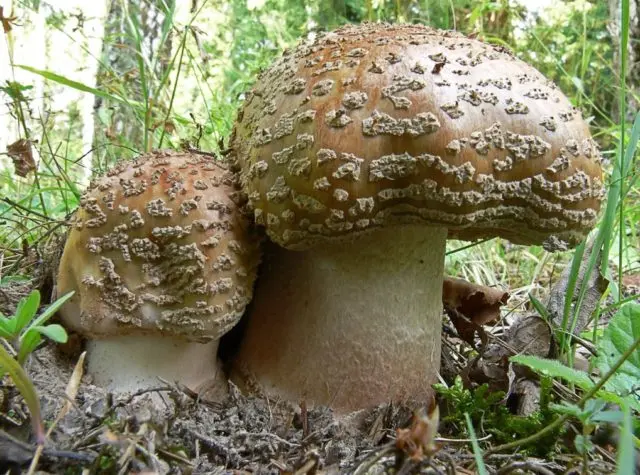
Cap Description
The cap of the pink mushroom is medium in size, about 15 cm in diameter, sometimes more or less. At a young age, it has a hemispherical or even ovoid shape, but subsequently becomes convex or flat-prostrate, and there is no noticeable tubercle in its center. The color of the hat, as the name implies and can be seen in the photo of the gray-pink fly agaric, is grayish-pink or reddish-brown, sometimes brown-red, slightly sticky to the touch and shiny. On the surface of the cap, membranous or warty flakes of white, dirty pink or brownish color can be observed.
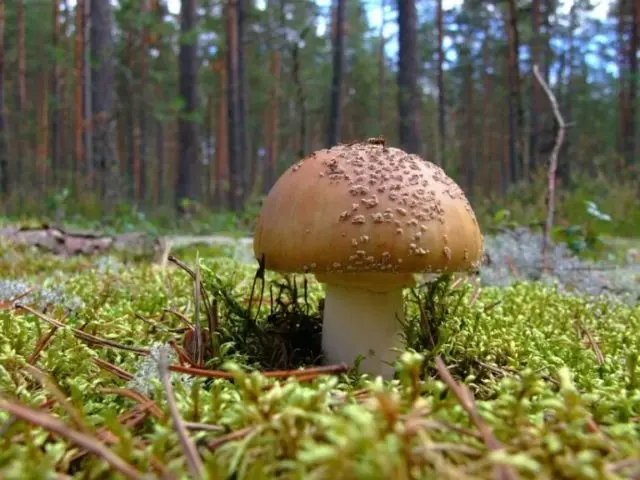
The photo of the pink fly agaric shows that on the underside the hat is covered with frequent wide white plates. If you touch them with your finger, they turn red just like the flesh on the cap and on the leg. At the break, the fruiting body is white, fleshy, with a neutral odor. From contact with air, the flesh first turns pink, and then acquires a rich wine-pink hue.
Description of the leg
On average, the leg of a gray-pink mushroom rises up to 10 cm above the ground, in rare cases it can rise by 20 cm. It usually reaches no more than 3 cm in thickness, is cylindrical in shape, dense at a young age, and then becomes hollow. The leg has a white or slightly pinkish color, its surface may be covered with tubercles, and a tuberous thickening is noticeable at the base.

Most often, on the stem of a gray-pink fly agaric, there are the remains of a ring, hanging, wide and membranous. At first they are white, turn pink with age, grooves can be seen on the surface.
Where and how to grow
You can meet a gray-pink mushroom throughout the entire Northern Hemisphere in a temperate climate. It prefers coniferous and mixed forests, it is especially common near pines and birches, as it forms a symbiosis with these trees.
It grows both alone and in small families. You can see it very often, and most massively it bears fruit from July to October.
Twins and their differences
The gray-pink fly agaric poses a certain danger to beginner mushroom pickers. There are quite a few species similar to it, and most of them are not just inedible, but highly poisonous. Therefore, before collecting, you need to carefully study the photo and description of the gray-pink fly agaric and its counterparts.
Royal fly agaric
This mushroom looks like a photo of an edible pink fly agaric in its size and structure. It has the same cap, convex at a young age and flattened in old fruiting bodies, a thin long stem with a tuberous base.
You can distinguish varieties by color – the hat of the royal species has an olive-red, dark brown or gray-yellow hue without an admixture of pink. In addition, if you break the mushroom, then its flesh will not be white, but yellowish.
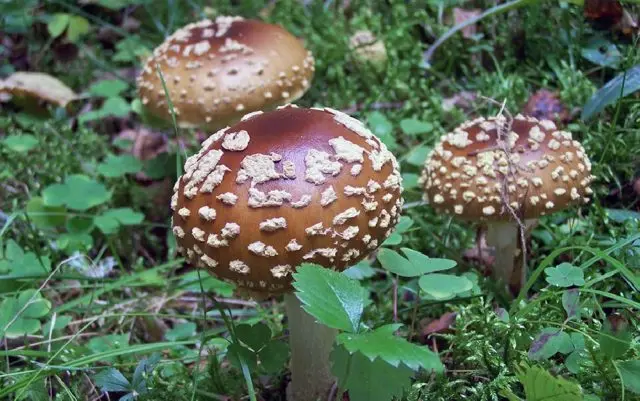
Amanita fat
This mushroom also resembles the edible pink fly agaric in appearance and size, and grows in the same places. The main difference lies in the shade of the cap – in the stocky species it is brown or silvery brown, covered with light gray flakes.
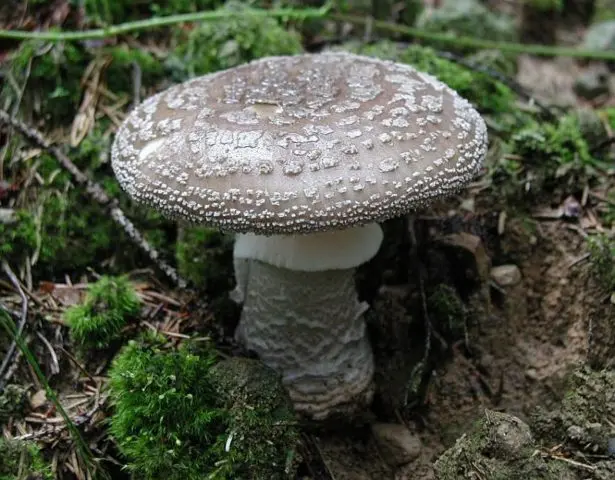
Also, a thick fly agaric is characterized by a faint smell of turnips, while the gray-pink variety does not have a specific aroma. The stocky fly agaric is conditionally edible, so confusing it with gray-pink is not so scary.
Leopard row
Inexperienced mushroom pickers may confuse a gray-pink fly agaric with a tiger, or leopard, row. It has at first a convex, and then a prostrate wide lamellar cap with a spotted structure, which may make it look like a fly agaric.
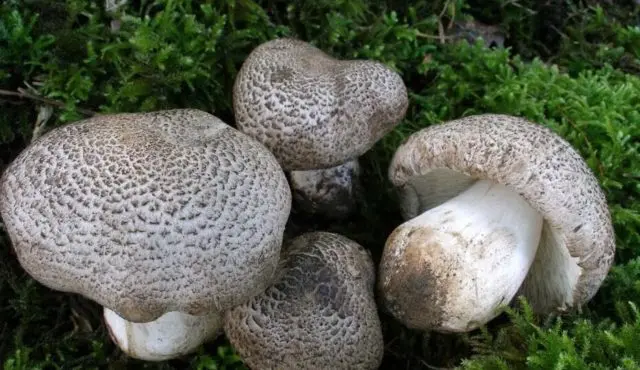
But the differences are quite significant, first of all, the spots on the surface of the cap are formed not by the remains of the bedspread, but by small scales, and they are not light, but dark. The shade of the cap is usually off-white, dark gray or silver-gray, with a bluish tint. If you break the row, then its flesh will turn out to be white, but it will not turn red from contact with air. The leopard row is very poisonous, so it should not be confused with edible fruiting bodies.
Death cap
In rare cases, it is possible to confuse a gray-pink fly agaric with a poisonous and dangerous pale grebe. Mushrooms are similar in size, their caps are prostrate in adulthood and lamellar, there is usually a ring on thin long legs.
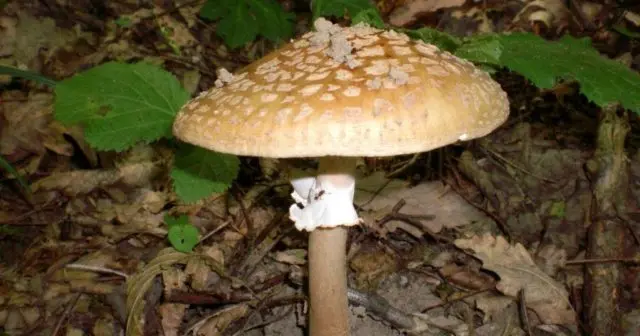
But the cap of the pale grebe does not have a pink tint, its color varies from white to brown-olive. The surface of the cap is silky, and there are usually no flakes characteristic of the fly agaric.
What is the difference between a gray-pink fly agaric and a panther
The most dangerous twin of the edible fly agaric is the panther fly agaric, a deadly poisonous mushroom. In appearance, they are almost identical, and although the color of the cap of the panther fly agaric is gray-brown or slightly olive, it is not so easy to catch this difference.
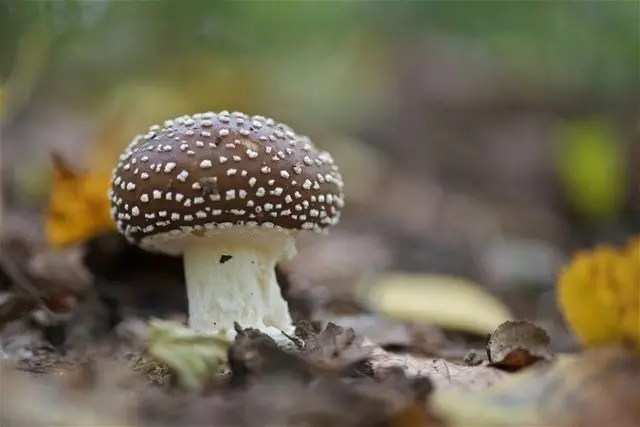
Therefore, when collecting, you need to focus on another sign. If you break the panther fly agaric, then its flesh will not change color from contact with air and remain white. But the gray-pink fly agaric always turns red when broken.
Is pink fly agaric edible or not
Gray-pink fly agaric is classified as a conditionally edible mushroom. The raw pulp contains toxic substances, however, during heat treatment, they are destroyed, and the mushroom becomes safe for consumption.
How to cook gray-pink fly agaric
For long-term storage, the edible gray-pink fly agaric is usually not harvested. It is customary to use it boiled and fried, heat treatment eliminates all potential danger.
Fruiting bodies must be carefully prepared before any preparation. First of all, the fly agaric is cleaned of debris and the remains of the cover are removed from the hat, and then the mushroom is washed in cool water and boiled thoroughly with salt for an hour. At the same time, water for cooking should be taken in a ratio of 3 to 1, changed at least once during boiling, and at the end of the process, it must be drained. It is impossible to use a decoction from under the fly agaric as a broth, toxic substances may remain in it.
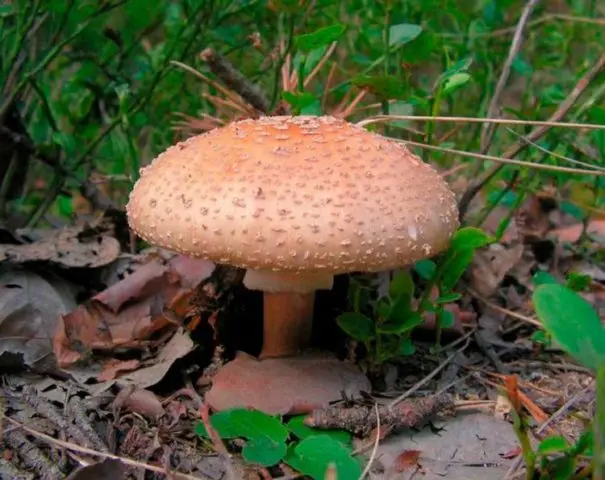
Pink fly agaric soup
Boiled pulp is often added to soup, the dish is tasty and nutritious. The recipe looks like this:
- Fresh fruit bodies are cleaned, washed and boiled in salt water, the broth is drained, and the mushrooms are thrown into a colander and rinsed with cool water.
- Hats and legs are cut into small pieces, again immersed in a pot of water and boiled for 10 minutes, after which 3 chopped fresh potatoes are added to the water.
- While mushrooms and potatoes are being cooked, carrots and 2 small onions are rubbed on a coarse grater, and then they are fried in a pan until golden brown.
- The broth with mushrooms and potatoes is salted to taste, onions and carrots are added, if desired, pepper and any greens are also put into the water.
You need to cook the soup for another 10 minutes. A couple of minutes before readiness, bay leaves are added to the broth, and then the soup is removed from the stove and served on the table in about half an hour with sour cream.
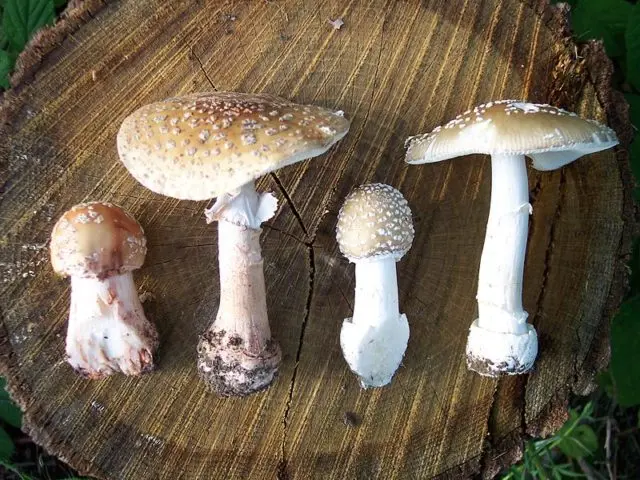
Fly agaric roast
Another simple recipe for a gray-pink fly agaric suggests frying the mushroom pulp. It’s very easy to do this:
- Fresh mushrooms are traditionally cleaned, washed and boiled, after which the water is drained, and the fruiting bodies themselves are washed again.
- The mushroom pulp is cut into small pieces, the pan is heated, greased with vegetable oil and the mushrooms are laid out.
- After 10 minutes, potatoes, cut into bars or slices, as well as onions are added to the pan, the food is salted to taste and, if desired, pepper is added.
You need to fry the mushroom pulp with onions and potatoes until the potatoes are fully cooked, after which the pan is removed from the stove and cooled for about 20 minutes. Then the dish can be served on the table with sour cream and herbs.
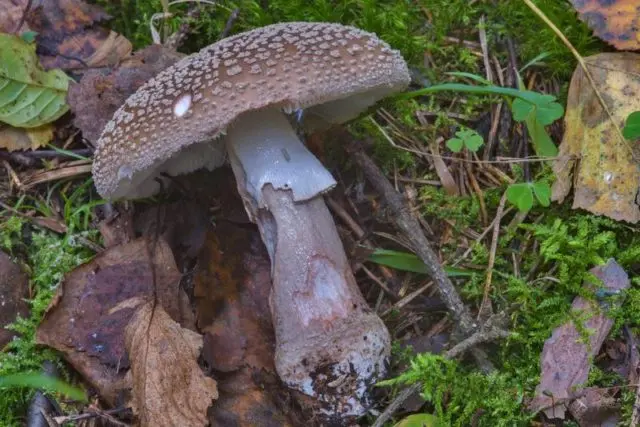
Useful properties and possible harm
Gray-pink fly agaric is valued not only for its pleasant taste, but also for its beneficial properties. Its pulp contains many vitamins, including betaine, which improves liver function and stimulates metabolism. Research is also underway on the positive effects of betaine on the body in Alzheimer’s disease and in oncological diseases. There is a lot of vegetable protein in the pulp, so the mushroom is beneficial on a vegetarian table and can replace meat.
At the same time, the composition of the gray-pink fly agaric includes the dangerous substance rubescenslysin, when it enters the human body, it causes the destruction of red blood cells and leads to hemorrhagic pulmonary edema. The toxin decomposes at temperatures above 80 ° C, which is why the gray-pink fly agaric must be boiled before use.
Even boiled pulp can pose a certain danger in chronic gastric and intestinal diseases and allergies to mushrooms. It is strictly forbidden to use gray-pink fly agaric for pregnant women and children, the slightest mistake in collecting and preparing them can be fatal.
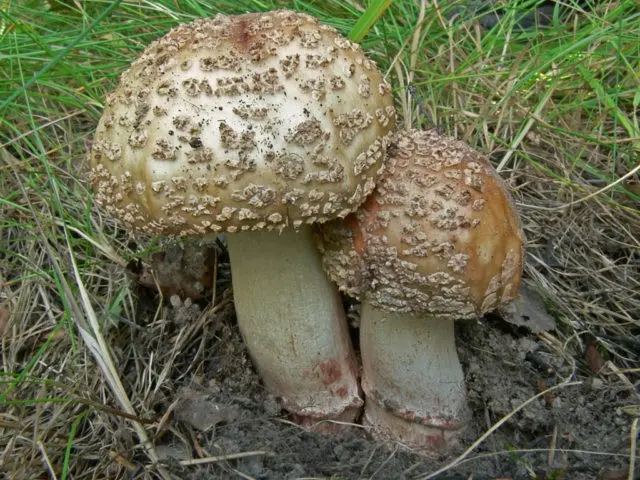
Interesting facts about pink fly agaric
The blushing fly agaric is a species that is very resistant to external conditions. It grows not only in temperate climates, but even in Africa, where extremely high temperatures are not uncommon.
Interesting features of the mushroom include its low calorie content. There are only 100 calories in 22 g of fresh mushrooms.
The taste of a blushing fly agaric, according to mushroom pickers, is slightly sweet. This is largely due to its popularity.
Conclusion
The gray-pink fly agaric is suitable for eating after heat treatment, since the toxins present in it are destroyed by high temperatures. But special care must be taken when collecting, the variety has many dangerous poisonous counterparts.









